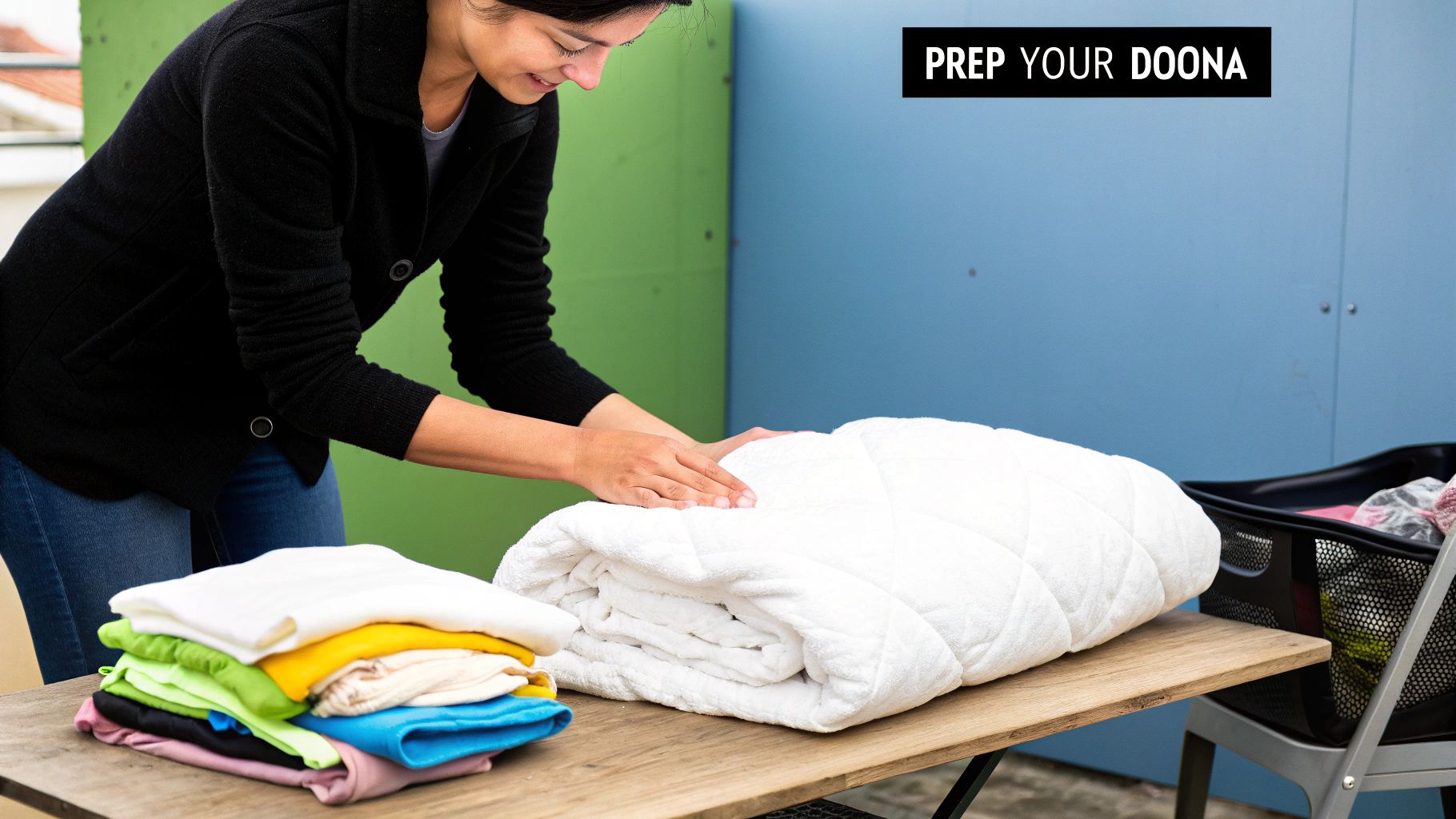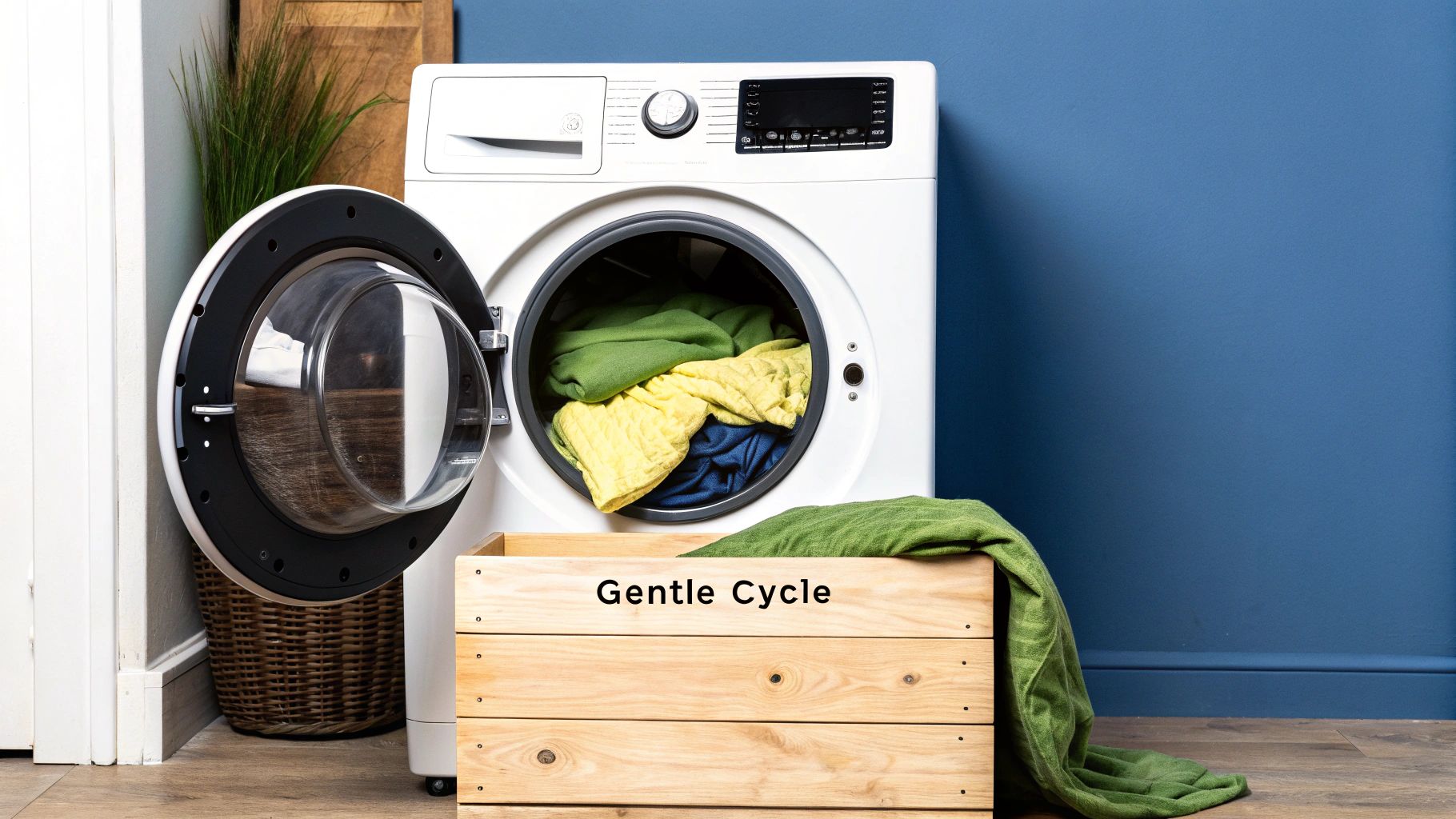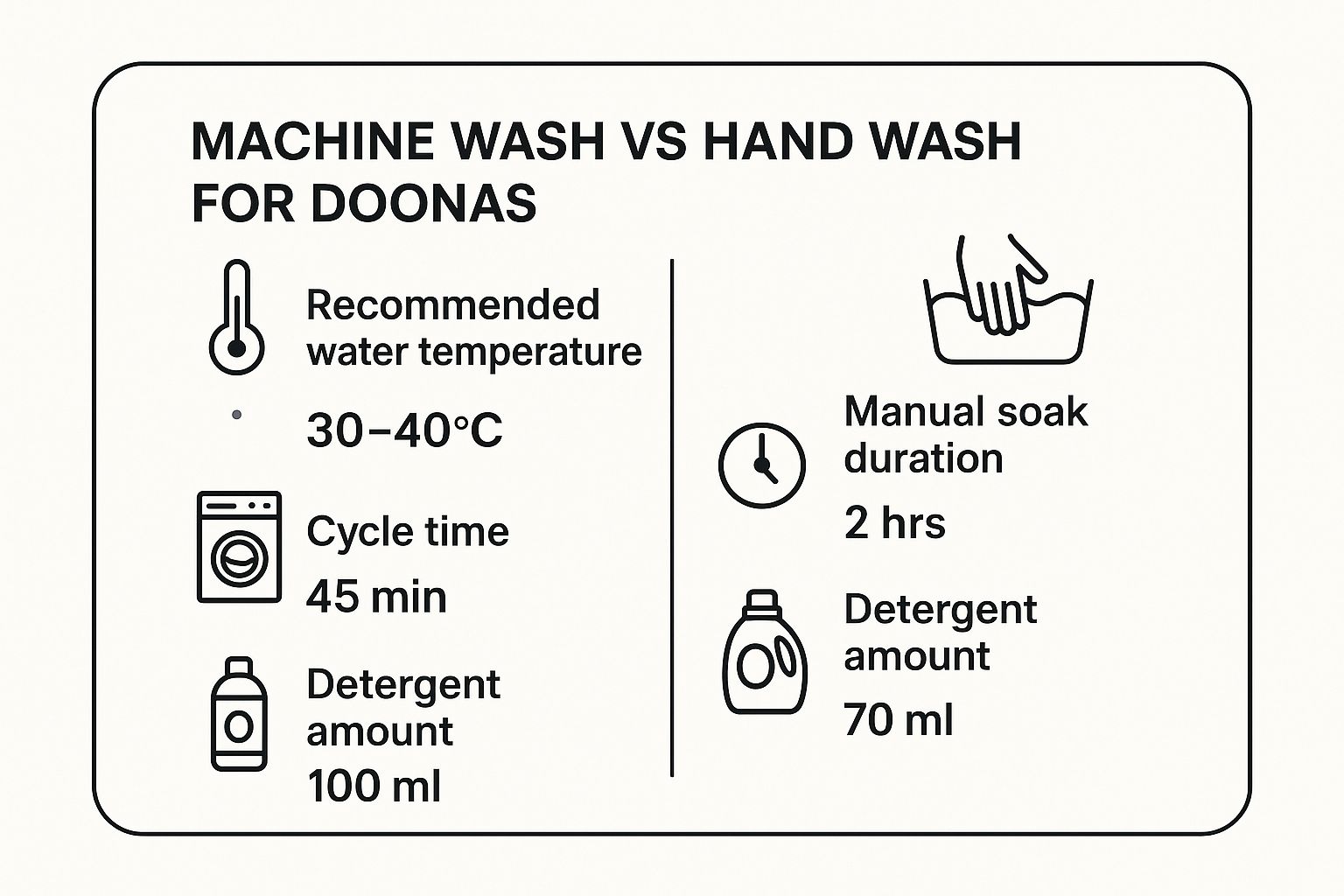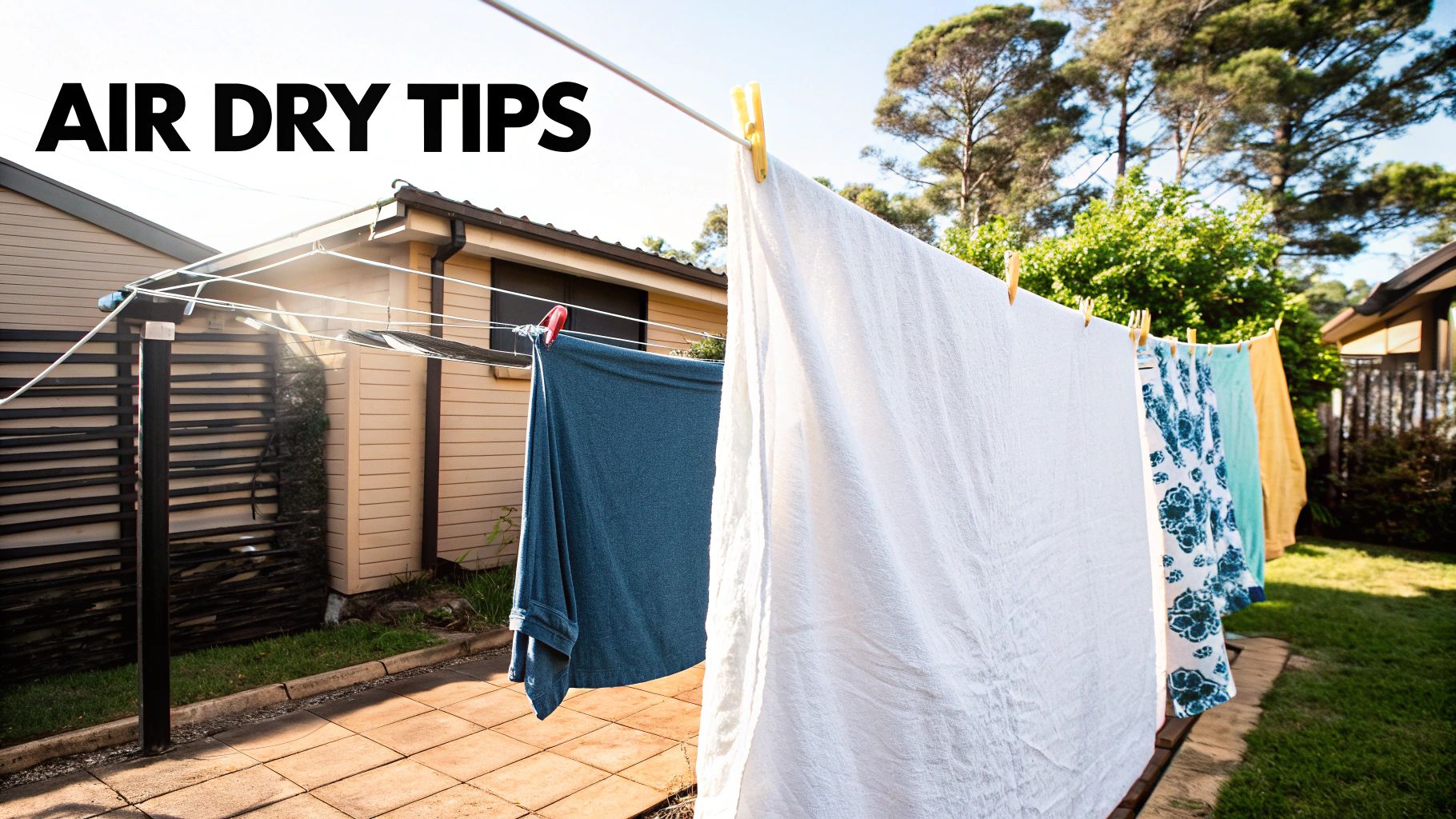Most people don’t wash their doona as often as they should — but did you know it can trap dust, sweat, and allergens over time? Proper washing isn't just about stain removal; it's crucial for hygiene, comfort, and the longevity of your bedding. A clean doona helps create a healthier sleep environment, free from the buildup that can trigger allergies or disrupt rest.
Regular, correct care keeps your doona fluffy, warm, and feeling fresh for years. If you’re wondering how to wash your doona at home without ruining it, this step-by-step guide makes it simple. We'll walk you through everything from understanding dust mites to mastering the drying process so it comes out feeling like new.
How Often Should You Wash a Doona?

This is one of those questions we get asked all the time. Unlike your sheets, your doona doesn't need a weekly wash, but leaving it too long is a recipe for dust mites and stale odours.
As a general rule, aim to wash your doona every six months. This timing lines up perfectly with the change of seasons, making it a simple habit to remember when you're swapping out your bedding anyway.
Of course, life isn't always that neat. Just like the advice on how often you should clean area rugs depends on foot traffic and spills, your doona's cleaning schedule depends entirely on how you use it.
When to Wash Your Doona More Often
You'll want to bump that schedule up to every three or four months if you:
- Suffer from allergies or asthma. A more frequent wash is your best defence against dust mites and other allergens that love to hide in bedding.
- Tend to sweat at night. Over time, moisture can lead to bacteria and mildew building up inside the filling.
- Let pets sleep on the bed. We love our furry friends, but they bring dander, dirt, and oils with them that can work their way into your doona.
Quick Care Hack: The easiest way to keep your doona cleaner for longer is to use a good quality doona cover. Wash the cover every one to two weeks along with your sheets, and you'll dramatically cut down on how often you need to tackle washing the doona itself.
Getting into a good rhythm for all your bedding is key to a healthier sleep space. Brushing up on how often to wash and replace all your bedding will help you create a routine that works.
Check the Care Label First

Before your doona goes anywhere near a washing machine, the first step is non-negotiable: read the manufacturer's care label. Think of this little tag as your instruction manual. Ignoring it is a gamble that could lead to shrinking, clumping, or permanent damage.
The label provides specific instructions based on the doona's filling and fabric. Common symbols include a tub icon (machine wash), a hand in a tub (hand wash), and a circle (dry clean only). The filling is the main reason for these different instructions.
- Down and Feather: These delicate natural fillings can be stripped of their insulating oils by harsh detergents or high heat.
- Wool: This material is prone to shrinking and felting, so it often requires professional dry cleaning or a very gentle hand wash.
- Synthetic Fibres: Materials like microfibre and polyester are generally more resilient and can handle a standard machine wash, but the label will specify the correct temperature.
For more specific advice on natural fillings, check out our guide on how to wash feather and down bedding.
Step-by-Step: How to Wash Your Doona at Home
Washing your doona at home is straightforward when you follow a clear process. Here’s how to get it clean, fluffy, and fresh without any drama.
Step 1: Pre-Check for Damage or Stains
Before washing, lay your doona out and inspect it for any tears or loose seams. Mend these first to prevent the filling from escaping. Spot clean any marks by dabbing them with a gentle stain remover or a small amount of mild liquid detergent.
Step 2: Choose the Right Machine
Your doona needs room to move. Use a large-capacity front-loader machine, which you can find at a laundromat if your home machine is too small or a top-loader. Avoid overloading the machine, as this prevents proper cleaning and rinsing.
Step 3: Pick the Right Detergent
Choose a gentle, fragrance-free, or sensitive skin liquid detergent. Less is more—using too much can leave residue. Avoid using bleach or fabric softeners, as they can damage the fibres and reduce the doona's fluffiness.
Step 4: Wash Settings
Select a gentle or delicate cycle with cold or warm water (never hot, as it can cause shrinking). For extra freshness and to ensure all soap is removed, add an optional extra rinse cycle.
Step 5: Drying Your Doona
The key to a fluffy doona is proper drying. Tumble dry on a low heat setting with dryer balls or clean tennis balls to break up clumps and restore loft. Alternatively, air dry your doona in the sunlight for natural freshness. Ensure it is completely dry before storing or putting it back on your bed to prevent mildew.
Can You Wash All Types of Doonas?
Not all doonas can be treated the same way. The filling dictates the best cleaning method, as each material reacts differently to water and heat.

Here's a breakdown of common fillings and their ideal washing instructions. For more specific advice, our guides on caring for bamboo quilts and how to care for your snuggle fleece comforter can help.
| Doona Material | Best Washing Method | Best Drying Method | Key Tip |
|---|---|---|---|
| Microfibre / Polyester | Machine wash, gentle cycle | Tumble dry on low heat | Durable and ideal for frequent washing. |
| Feather or Down | Gentle machine wash, cold water | Tumble dry on low with dryer balls | Must be completely dry to restore fluff. |
| Wool | Hand wash or dry clean only | Air dry flat, away from direct sun | Avoid machine washing to prevent shrinking. |
| Bamboo or Cotton | Cold, gentle machine wash | Air dry or tumble dry on low | Use a mild detergent to protect fibres. |
Common Mistakes to Avoid
A few simple mistakes can ruin a perfectly good doona. Be sure to avoid:
- Using too much detergent: It leaves residue and can weigh down the filling.
- Not drying thoroughly: This is the #1 cause of mildew and musty smells.
- Ignoring the care label: The manufacturer's instructions are there for a reason.
- Washing in hot water: It can cause shrinking and damage delicate fibres.
- Folding or storing while damp: Always ensure your doona is 100% dry.
How to Keep Your Doona Fresher for Longer

Good doona care goes beyond laundry day. A few simple habits can extend its life and keep it feeling clean.
- Use a doona cover: This is the most effective tip. A cover protects your doona from sweat, oils, and dust. Wash it weekly with your sheets. Understanding why a quilt cover is important is key to easier bedding care.
- Air it out monthly: Hang your doona outside in the sun for a few hours. Fresh air helps eliminate odours, while UV rays act as a natural disinfectant.
- Store it properly: When not in use, store your doona in a breathable cotton bag, not plastic, to prevent moisture buildup.
- Rotate seasonally: Switching between a summer and winter doona gives each one a rest, helping to preserve its shape and loft.
For more tips on your entire sleep setup, explore our guide on how to clean and maintain all types of bedding.
👉 Looking to upgrade? Explore our range of machine-washable comforters and quilts designed for easy care.
Your Doona Washing Questions Answered
We’ve put together answers to the most common questions about doona care.
1. Can I wash my doona in a washing machine?
Yes—most synthetic and lightweight doonas can be machine washed. Check your care label first and make sure your machine is large enough to handle the bulk without being overloaded.
2. How do I dry a doona fast?
Use a dryer on low heat with dryer balls to speed up the process and fluff the filling. Alternatively, hang your doona in full sunlight for a few hours for natural, fast drying.
3. How often should I wash my doona cover?
Wash your doona cover every 1–2 weeks, along with your other bedding, to keep your doona fresh and hygienic.
4. Can I dry-clean my doona instead?
Yes—especially if it’s wool or down-filled. Dry cleaning is often the safest option for delicate materials. Always follow the care label’s recommendation.
5. What’s the best doona for easy washing?
Look for a machine-washable comforter or doona designed for low-maintenance care—like the ones in our Morgan & Reid and Sienna Living collections. Synthetic fillings are typically the easiest to wash at home.
Conclusion
Washing your doona is easier than most people think, and it's a vital part of maintaining a hygienic and comfortable bed. By following these simple steps and paying attention to your doona's specific needs, you can keep it in excellent condition for years. A seasonal refresh is all it takes.
A clean doona means fresher sleep, every night.
Ready for an upgrade? Explore our collection of easy-care, machine-washable bedding, including comfortable comforters and breathable bamboo quilts.

